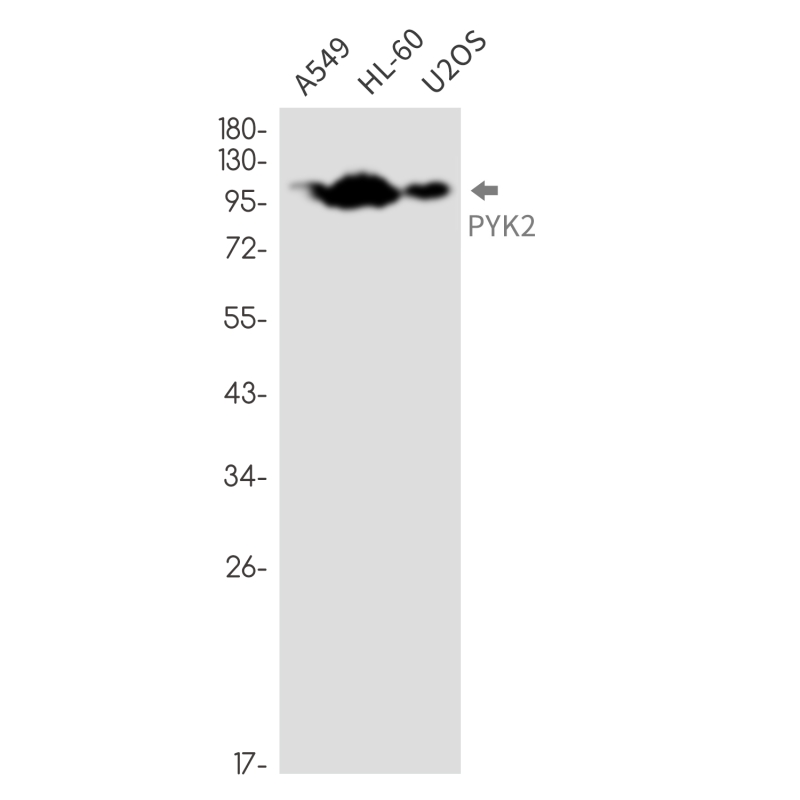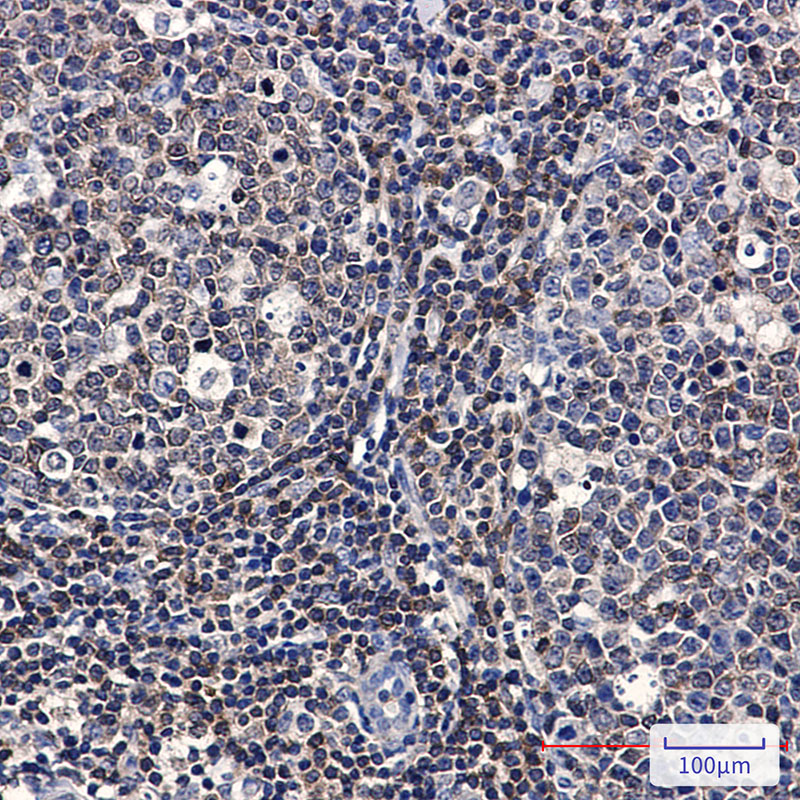

| WB | 1/500-1/1000 | Human,Mouse,Rat |
| IF | 1/20 | Human,Mouse,Rat |
| IHC | 1/50-1/100 | Human,Mouse,Rat |
| ICC | 技术咨询 | Human,Mouse,Rat |
| FCM | 咨询技术 | Human,Mouse,Rat |
| Elisa | 咨询技术 | Human,Mouse,Rat |
| Aliases | PTK2B; FAK2; PYK2; RAFTK; Protein-tyrosine kinase 2-beta; Calcium-dependent tyrosine kinase; CADTK; Calcium-regulated non-receptor proline-rich tyrosine kinase; Cell adhesion kinase beta; CAK-beta; CAKB; Focal adhesion kinase 2; FADK 2; Pro |
| Entrez GeneID | 2185 |
| WB Predicted band size | Calculated MW: 116 kDa; Observed MW: 116 kDa |
| Host/Isotype | Rabbit IgG |
| Antibody Type | Primary antibody |
| Storage | Store at 4°C short term. Aliquot and store at -20°C long term. Avoid freeze/thaw cycles. |
| Species Reactivity | Human |
| Immunogen | A synthetic peptide of human PYK2 |
| Formulation | Purified antibody in TBS with 0.05% sodium azide,0.05%BSA and 50% glycerol. |
+ +
以下是3篇涉及PYK2抗体的文献及其摘要内容:
---
1. **文献名称**: *"Role of PYK2 in Cancer Cell Migration and Invasion"*
**作者**: Li et al. (2018)
**摘要**: 该研究通过Western blot和免疫荧光技术,使用PYK2特异性抗体,发现PYK2在乳腺癌细胞中通过激活RhoA/ROCK通路促进细胞迁移和侵袭,提示其作为潜在治疗靶点。
2. **文献名称**: *"PYK2 Mediates Neurodegeneration in Alzheimer's Disease Models"*
**作者**: Smith et al. (2020)
**摘要**: 利用PYK2抗体进行免疫组化分析,作者发现PYK2在阿尔茨海默病小鼠模型的神经元中异常激活,与Tau蛋白磷酸化及突触功能障碍相关,抑制PYK2可缓解病理表型。
3. **文献名称**: *"PYK2 Regulates Inflammatory Signaling in Macrophages"*
**作者**: Wang & Chen (2019)
**摘要**: 研究通过siRNA敲低和PYK2抗体免疫沉淀实验,证明PYK2与TLR4受体相互作用,调控巨噬细胞中NF-κB信号通路,影响炎症因子释放,为免疫调节提供新机制。
---
以上文献均为示例,实际引用需根据具体研究补充完整信息(期刊名称、卷号、页码等)。如需更精准的文献,建议通过PubMed或Google Scholar检索关键词“PYK2 antibody”、“PTK2B antibody”等。
**Background of PYK2 Antibody**
PYK2 (proline-rich tyrosine kinase 2), also known as PTK2B or CAKβ, is a non-receptor tyrosine kinase belonging to the focal adhesion kinase (FAK) family. Structurally, it contains an N-terminal FERM domain, a central kinase domain, and C-terminal proline-rich regions that mediate interactions with signaling adaptors. Unlike FAK, PYK2 is highly expressed in the central nervous system and hematopoietic cells, where it regulates diverse cellular processes, including cell migration, proliferation, apoptosis, and cytoskeletal reorganization.
PYK2 activation is triggered by extracellular stimuli such as stress signals, cytokines, and GPCR agonists, leading to its autophosphorylation and recruitment of downstream effectors like Src family kinases, Grb2. and PI3K. It integrates signals from multiple pathways, including MAPK, Rho GTPases, and calcium signaling, influencing synaptic plasticity, immune responses, and bone metabolism. Dysregulation of PYK2 is implicated in pathologies such as cancer metastasis, neurodegenerative disorders (e.g., Alzheimer’s), inflammatory diseases, and osteoporosis.
PYK2 antibodies are essential tools for studying its expression, activation (e.g., phosphorylation at Tyr402), and localization in tissues or cultured cells. They are widely used in techniques like Western blotting, immunohistochemistry, and immunofluorescence. Additionally, PYK2-targeting antibodies or inhibitors are being explored for therapeutic intervention in diseases linked to aberrant PYK2 signaling.
×